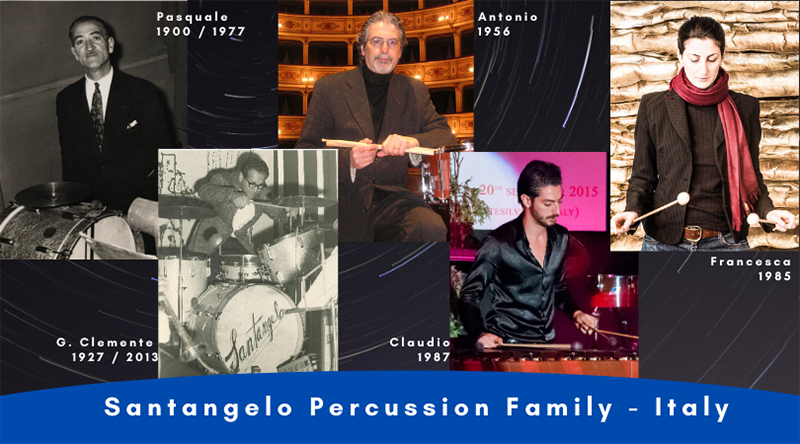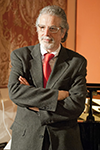by
Rhythm Scene Staff
| Jun 25, 2021
We’d like to tell our readers a unique and fantastic story of a four-generation Italian percussionist family. Antonio Santangelo (president of PAS Italy since 2003) describes some of the heritage and legacy of this Italian percussion dynasty.

My father (born in 1927) was a drummer, but he had a fantastic quality: he knew how to listen. His first example of emulation was my grandfather Pasquale (1900–1977). Almost all percussionists have experience in light music with the drums; my father is one of them. After the drums, he pursued his passion for classical music and studied percussion and piano. This gave me a more complete vision of those instruments. I was very lucky because of that.
My father studied alone when he began, working to repeat the rhythms he heard. Little by little, when he was only 13, he started to replace my grandfather in his group, given that for him it was easy to emulate and create new rhythms. My father was able to learn everything he needed from the American bands of that time; that’s primarily how he learned, by listening.
In 1946 he started his piano studies, and two years after that he started to play as a drummer for the great bands of that period. His famous “solos” gave him the chance to start the career that brought him to become one of the first drummers of RAI (Radiotelevisione Italiana, Italian national television broadcasting channel) with the prestigious Orchestra di musica leggera di Roma (Rome Orchestra of light music). In fact, when my father accompanied me to the RAI studios in Rome for my very first contract, we went to the same place where he had recorded. It was amazing! Twenty years later I brought my daughter Francesca to the exact same place, for a tryout as a percussionist for the EUYO orchestra. At that time, being an RAI musician was a great honor. Nevertheless, my father instead had to make the difficult decision to give all of that up to come back to Foggia to his family and accept a simple job as a factory worker. I’m sure that if he hadn’t made that choice, I would have taken a different life path.
Despite that difficult choice, he still won numerous official prizes and contributed greatly to the teaching of drums. In 1965, he won Maschera d’Argento (silver mask) and in 1990, La Batteria d’Argento (silver drums) given by Andrea Centazzo during a drummer competition. Recently, the writer Luca Luciani told his story in the book I padri della batteria in Italia (The fathers of the drums in Italy), and for many years at the National Competition U. Giordano of Foggia has been dedicated as the Prize "G. Clemente Santangelo" in the category where young, talented drummers are awarded. Given his great technical and musical experience and teaching methods, he was able to write Invito alla batteria published by Beben. The book, with his simple and clear way of teaching, has filled up some gaps that have been present in the teaching methods from 1970 to today.
In all this, he was greatly influenced by the notable American drummers like Gene Krupa, Max Roach, and Buddy Rich. When he performed, his style was similar to theirs; that’s why he is thought to be great. The first drums he played were made by my grandfather and my father with chocolate tins brought by the American soldiers during WWII. His first professional set was made by Desidera (Italian brand) in an Italian factory. In 1970, before his book was released, he bought a Sonor drum set with Zildijan cymbals. I still have them and treasure them.
Our family continues this legacy; we’re not that different than most families, but music is our reason to live. Times have changed over these multiple generations though. In the past we had to construct the drum sets, but today we can take advantage of a wide range of instruments. In the past we had to use our imagination to create a new rhythm; now, thanks to the internet, we have all the great artists we want at the click of a mouse. My family is composed of me, my father, my grandfather, and my wife, Maria Vittorio, also a percussion teacher at the Conservatory since 1970.
Also, I have two children who have joined the music scene: Claudio and Francesca. Both of them have studied and have graduated at the Conservatory in Fermo. Francesca has a degree by the Stuttgart University of Music. She moved to Freiburg after winning an audition at the Opera Theatre as a percussionist. She is currently teaching and is touring the world. She comes back to Italy every year for our Days of Percussion festival in September and to collaborate with the National Symphony Orchestra in Tourin. Claudio is a marimba player and composer, and he is considered by the critics as one of the youngest and most brilliant talents in the world of solo percussion. He has got a musical sensibility and compositional creativity that put him on top of the talent list. His CD Music for You has been reviewed well by Percussive Notes. In 2011 he won the National Award of Art and he teaches masterclasses and performs both in Europe and China. Today he teaches percussion at the Campobasso Conservatory of Music L. Perosi.
The Santangelo family is one of few families that has a tradition of four generations of percussionists and four percussionists in one family. I am quite proud that this family is mine.
 Antonio Santangelo holds degrees in piano and percussion. He has recorded for RCA, Edipan, and Nuova Era. He gave the first performances of compositions by Rota, Togni, Bussotti, Sciarrino, Clementi, Donatoni, Pennisi, Manzoni, Maderna, Procaccini, Nono, and more. Since 1974, he has had an intense collaboration as timpanist and percussionist with prestigious Italian theaters and with the RAI Orchestra of Turin and Naples. He has also collaborated with the RAI Orchestra of Rome as drummer and percussionist. He won the National Competition organized by the RAI "Giovani Interpreti,” recording for RAI UNO the first performance in Italy of "Concertino" by Mayuzumi with the RAI Symphony Orchestra of Turin. Since 1987, he has been dedicated to the organization of percussion competitions and festivals. The Italy Percussion Competition and the Days of Percussion are famous all over the world. For this dedication and importance of his initiatives, in 2010 he received the Medal from the President of the Republic Giorgio Napolitano. Since 1977, he has also been teaching professor of percussion instruments, currently at the L. D'Annunzio Conservatory of Music in Pescara-Italy. He is invited in the juries of international competitions and in concerts and master classes in Europe, is President of the PAS Italy Chapter, and at PASIC 2007, he received special recognition for his professional activity. His Progressive Method for Snare Drum is published and distributed by HoneyRock.
Antonio Santangelo holds degrees in piano and percussion. He has recorded for RCA, Edipan, and Nuova Era. He gave the first performances of compositions by Rota, Togni, Bussotti, Sciarrino, Clementi, Donatoni, Pennisi, Manzoni, Maderna, Procaccini, Nono, and more. Since 1974, he has had an intense collaboration as timpanist and percussionist with prestigious Italian theaters and with the RAI Orchestra of Turin and Naples. He has also collaborated with the RAI Orchestra of Rome as drummer and percussionist. He won the National Competition organized by the RAI "Giovani Interpreti,” recording for RAI UNO the first performance in Italy of "Concertino" by Mayuzumi with the RAI Symphony Orchestra of Turin. Since 1987, he has been dedicated to the organization of percussion competitions and festivals. The Italy Percussion Competition and the Days of Percussion are famous all over the world. For this dedication and importance of his initiatives, in 2010 he received the Medal from the President of the Republic Giorgio Napolitano. Since 1977, he has also been teaching professor of percussion instruments, currently at the L. D'Annunzio Conservatory of Music in Pescara-Italy. He is invited in the juries of international competitions and in concerts and master classes in Europe, is President of the PAS Italy Chapter, and at PASIC 2007, he received special recognition for his professional activity. His Progressive Method for Snare Drum is published and distributed by HoneyRock.